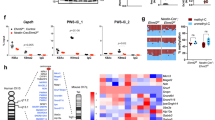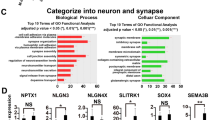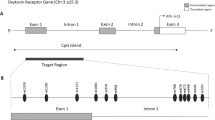Abstract
The Prader–Willi syndrome (PWS) is caused by a 5–6 Mbp de novo deletion on the paternal chromosome 15, maternal uniparental disomy 15 or an imprinting defect. All three lesions lead to the lack of expression of imprinted genes that are active on the paternal chromosome only: MKRN3, MAGEL2, NDN, C15orf2, SNURF-SNRPN and more than 70 C/D box snoRNA genes (SNORDs). The contribution to PWS of any of these genes is unknown, because no single gene mutation has been described so far. We report on two patients with PWS who have an atypical deletion on the paternal chromosome that does not include MKRN3, MAGEL2 and NDN. In one of these patients, NDN has a normal DNA methylation pattern and is expressed. In another patient, the paternal alleles of these genes are deleted as the result of an unbalanced translocation 45,X,der(X)t(X;15)(q28;q11.2). This patient is obese and mentally retarded, but does not have PWS. We conclude that a deficiency of MKRN3, MAGEL2 and NDN is not sufficient to cause PWS.
Similar content being viewed by others
Log in or create a free account to read this content
Gain free access to this article, as well as selected content from this journal and more on nature.com
or
References
Buiting K, Nazlican H, Galetzka D, Wawrzik M, Gross S, Horsthemke B : C15orf2 and a novel noncoding transcript from the Prader–Willi/Angelman syndrome region show monoallelic expression in fetal brain. Genomics 2007; 89: 588–595.
Sun Y, Nicholls RD, Butler MG, Saitoh S, Hainline BE, Palmer CG : Breakage in the SNRPN locus in a balanced 46,XY,t(15;19) Prader–Willi syndrome patient. Hum Mol Genet 1996; 5: 517–524.
Kuslich CD, Kobori JA, Mohapatra G, Gregorio-King C, Donlon TA : Prader–Willi syndrome is caused by disruption of the SNRPN gene. Am J Hum Genet 1999; 64: 70–76.
Schulze A, Hansen C, Skakkebaek NE, Brondum-Nielsen K, Ledbeter DH, Tommerup N : Exclusion of SNRPN as a major determinant of Prader–Willi syndrome by a translocation breakpoint. Nat Genet 1996; 12: 452–454.
Conroy JM, Grebe TA, Becker LA et al: Balanced translocation 46,XY,t(2;15)(q37.2;q11.2) associated with atypical Prader–Willi syndrome. Am J Hum Genet 1997; 61: 388–394.
Wirth J, Back E, Huttenhofer A et al: A translocation breakpoint cluster disrupts the newly defined 3′ end of the SNURF-SNRPN transcription unit on chromosome 15. Hum Mol Genet 2001; 10: 201–210.
Schule B, Albalwi M, Northrop E et al: Molecular breakpoint cloning and gene expression studies of a novel translocation t(4;15)(q27;q11.2) associated with Prader–Willi syndrome. BMC Med Genet 2005; 6: 18.
Gallagher RC, Pils B, Albalwi M, Francke U : Evidence for the role of PWCR1/HBII-85 C/D box small nucleolar RNAs in Prader–Willi syndrome. Am J Hum Genet 2002; 71: 669–678.
Ding F, Prints Y, Dhar MS et al: Lack of Pwcr1/MBII-85 snoRNA is critical for neonatal lethality in Prader–Willi syndrome mouse models. Mamm Genome 2005; 16: 424–431.
Sahoo T, del Gaudio D, German JR et al: Prader–Willi phenotype caused by paternal deficiency for the HBII-85 C/D box small nucleolar RNA cluster. Nat Genet 2008; 40: 719–721.
Koehler A : Chromosome staining; in Wegner ED (ed):: Diagnostic Cytogenetics. Berlin: Springer Verlag, 1999, pp 52–74.
Liehr T, Claussen U : FISH on chromosome preparations of peripheral blood; in Rautenstrauß BW, Liehr T (eds):: FISH Technology. Berlin: Springer Verlag, 2002, pp 73–81.
Zeschnigk M, Schmitz B, Dittrich B, Buiting K, Horsthemke B, Doerfler W : Imprinted segments in the human genome: different DNA methylation patterns in the Prader–Willi/Angelman syndrome region as determined by the genomic sequencing method. Hum Mol Genet 1997; 6: 387–395.
Kanber D, Buiting K, Zeschnigk M, Ludwig M, Horsthemke B : Low frequency of imprinting defects in ICSI children born small for gestational age. Eur J Hum Genet, doi:10.1038/ejhg.2008.177.
Buiting K, Barnicoat A, Lich C, Pembrey M, Malcolm S, Horsthemke B : Disruption of the bipartite imprinting center in a family with Angelman syndrome. Am J Hum Genet 2001; 68: 1290–1294.
Nannya Y, Sanada M, Nakazaki K et al: A robust algorithm for copy number detection using high-density oligonucleotide single nucleotide polymorphism genotyping arrays. Cancer Res 2005; 65: 6071–6079.
Holm VA, Cassidy SB, Butler MG et al: Prader-Willi syndrome: consensus diagnostic criteria. Pediatrics 1993; 91: 398–402.
Robinson WP, Bottani A, Xie YG et al: Molecular, cytogenetic, and clinical investigations of Prader–Willi syndrome patients. Am J Hum Genet 1991; 49: 1219–1234.
Buiting K, Dittrich B, Gross S et al: Molecular definition of the Prader–Willi syndrome chromosome region and orientation of the SNRPN gene. Hum Mol Genet 1993; 2: 1991–1994.
Hamabe J, Kuroki Y, Imaizumi K et al: DNA deletion and its parental origin in Angelman syndrome patients. Am J Med Genet 1991; 41: 64–68.
Burger J, Horn D, Tonnies H, Neitzel H, Reis A : Familial interstitial 570 kbp deletion of the UBE3A gene region causing Angelman syndrome but not Prader–Willi syndrome. Am J Med Genet 2002; 111: 233–237.
Runte M, Varon R, Horn D, Horsthemke B, Buiting K : Exclusion of the C/D box snoRNA gene cluster HBII-52 from a major role in Prader–Willi syndrome. Hum Genet 2005; 116: 228–230.
Skryabin BV, Gubar LV, Seeger B et al: Deletion of the MBII-85 snoRNA gene cluster in mice results in postnatal growth retardation. PLoS Genet 2007; 3: e235.
Ding F, Li HH, Zhang S et al: SnoRNA Snord116 (Pwcr1/MBII-85) deletion causes growth deficiency and hyperphagia in mice. PLoS ONE 2008; 3: e1709.
Bischof JM, Stewart CL, Wevrick R : Inactivation of the mouse Magel2 gene results in growth abnormalities similar to Prader–Willi syndrome. Hum Mol Genet 2007; 16: 2713–2719.
Kozlov SV, Bogenpohl JW, Howell MP et al: The imprinted gene Magel2 regulates normal circadian output. Nat Genet 2007; 39: 1266–1272.
Gerard M, Hernandez L, Wevrick R, Stewart CL : Disruption of the mouse necdin gene results in early post-natal lethality. Nat Genet 1999; 23: 199–202.
Muscatelli F, Abrous DN, Massacrier A et al: Disruption of the mouse Necdin gene results in hypothalamic and behavioral alterations reminiscent of the human Prader–Willi syndrome. Hum Mol Genet 2000; 9: 3101–3110.
Andrieu D, Meziane H, Marly F, Angelats C, Fernandez PA, Muscatelli F : Sensory defects in Necdin deficient mice result from a loss of sensory neurons correlated within an increase of developmental programmed cell death. BMC Dev Biol 2006; 6: 56.
Farber C, Gross S, Neesen J, Buiting K, Horsthemke B : Identification of a testis-specific gene (C15orf2) in the Prader–Willi syndrome region on chromosome 15. Genomics 2000; 65: 174–183.
Tsai TF, Jiang YH, Bressler J, Armstrong D, Beaudet AL : Paternal deletion from Snrpn to Ube3a in the mouse causes hypotonia, growth retardation and partial lethality and provides evidence for a gene contributing to Prader–Willi syndrome. Hum Mol Genet 1999; 8: 1357–1364.
Kishore S, Stamm S : The snoRNA HBII-52 regulates alternative splicing of the serotonin receptor 2C. Science 2006; 311: 230–232.
Acknowledgements
We thank the patients and the families for their cooperation, Ludger Klein-Hitpaß for SNP array analysis, Norbert Hödebeck-Stuntebeck for assistance in the clinical evaluation of patient 3 and Christina Lich for expert technical assistance. This study was supported by the Deutsche Forschungsgemeinschaft (BU907/1-4) and the EU (LSHM-CT-2005-512136).
Author information
Authors and Affiliations
Corresponding author
Additional information
Supplementary Information accompanies the paper on European Journal of Human Genetics website (http://www.nature.com/ejhg)
Supplementary information
Rights and permissions
About this article
Cite this article
Kanber, D., Giltay, J., Wieczorek, D. et al. A paternal deletion of MKRN3, MAGEL2 and NDN does not result in Prader–Willi syndrome. Eur J Hum Genet 17, 582–590 (2009). https://doi.org/10.1038/ejhg.2008.232
Received:
Revised:
Accepted:
Published:
Issue date:
DOI: https://doi.org/10.1038/ejhg.2008.232
Keywords
This article is cited by
-
Epigenetics meets GPCR: inhibition of histone H3 methyltransferase (G9a) and histamine H3 receptor for Prader–Willi Syndrome
Scientific Reports (2020)
-
Schaaf-Yang syndrome shows a Prader-Willi syndrome-like phenotype during infancy
Orphanet Journal of Rare Diseases (2019)
-
Update of the EMQN/ACGS best practice guidelines for molecular analysis of Prader-Willi and Angelman syndromes
European Journal of Human Genetics (2019)
-
Targeting the histone methyltransferase G9a activates imprinted genes and improves survival of a mouse model of Prader–Willi syndrome
Nature Medicine (2017)
-
Clinical phenotypes of MAGEL2 mutations and deletions
Orphanet Journal of Rare Diseases (2014)



